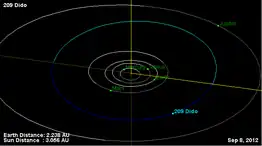209 Dido
Dido (minor planet designation: 209 Dido) is a main-belt asteroid with a diameter of 179±1 km.[4] It was discovered by C. H. F. Peters on October 22, 1879, in Clinton, New York and was named after the mythical Carthaginian queen Dido. This asteroid is orbiting the Sun at a distance of 3.15 AU with an eccentricity (ovalness) of 0.058 and a period of 5.59 yr. The orbital plane is tilted at an angle of 7.2° to the plane of the ecliptic.[4]
 | |
| Discovery | |
|---|---|
| Discovered by | C. H. F. Peters |
| Discovery date | 22 October 1879 |
| Designations | |
| (209) Dido | |
| Pronunciation | /ˈdaɪdoʊ/[1] |
Named after | Dido |
| A879 UC, 1909 AB 1909 GB, 1912 RB | |
| Main belt | |
| Adjectives | Didonian /daɪˈdoʊniən/[2][3] |
| Orbital characteristics[4] | |
| Epoch 31 July 2016 (JD 2457600.5) | |
| Uncertainty parameter 0 | |
| Observation arc | 136.47 yr (49,845 d) |
| Aphelion | 3.331 AU (498.3 Gm) |
| Perihelion | 2.968 AU (444.1 Gm) |
| 3.150 AU (471.2 Gm) | |
| Eccentricity | 0.057565 |
| 5.59 yr (2,040.5 d) | |
Average orbital speed | 16.79 km/s |
| 311.722° | |
| 0° 10m 34.738s / day | |
| Inclination | 7.16997° |
| 0.682681° | |
| 248.387° | |
| Physical characteristics | |
| Dimensions | 179±1 km[4] 140.35±10.12 km[5] |
| Mass | (4.59±7.42)×1018 kg[5] |
| 5.737 h (0.24 d)[4][6] | |
| 0.028±0.004 | |
| C | |
| 8.24 | |
_Dido.png.webp)
209 Dido is classified as a C-type asteroid and is probably composed of carbonaceous materials. Like many asteroids of its type, it has an extremely low albedo. Photometric observations at the Palmer Divide Observatory during 2005 showed a rotation period of 5.7366±0.0005 hours with a brightness variation of 0.17±0.02 in magnitude.[6] The pole orientation in ecliptic coordinates, as determined from multiple light curve studies, is (βp, λp) = (120°±6°, 66°±7°).[7]
209 Dido has been observed to occult 4 stars between 2005 and 2023.
References
- Webster, Noah (1884). A Practical Dictionary of the English Language.
- "didonia". Oxford English Dictionary (Online ed.). Oxford University Press. (Subscription or participating institution membership required.)
- Shoaf, Richard (1983). Dante, Chaucer, and the currency of the word. p. 52 ff.
- "209 Dido". JPL Small-Body Database. NASA/Jet Propulsion Laboratory. Retrieved 12 May 2016.
- Carry, B. (December 2012), "Density of asteroids", Planetary and Space Science, vol. 73, pp. 98–118, arXiv:1203.4336, Bibcode:2012P&SS...73...98C, doi:10.1016/j.pss.2012.03.009. See Table 1.
- Warner, Brian D. (December 2005), "Asteroid lightcurve analysis at the Palmer Divide Observatory - spring 2005", The Minor Planet Bulletin, 32 (4): 90–92, Bibcode:2005MPBu...32...90W.
- Zhang, Xi-Liang; et al. (December 2007). "Shapes and Pole Orientations of Asteroids (360) Carlova and (209) Dido". Earth, Moon, and Planets. 101 (3–4): 189–194. Bibcode:2007EM&P..101..189Z. doi:10.1007/s11038-008-9229-z.
External links
- Lightcurve plot of 209 Dido, Palmer Divide Observatory, B. D. Warner (2005)
- Asteroid Lightcurve Database (LCDB), query form (info Archived 16 December 2017 at the Wayback Machine)
- Dictionary of Minor Planet Names, Google books
- Asteroids and comets rotation curves, CdR – Observatoire de Genève, Raoul Behrend
- Discovery Circumstances: Numbered Minor Planets (1)-(5000) – Minor Planet Center
- 209 Dido at AstDyS-2, Asteroids—Dynamic Site
- 209 Dido at the JPL Small-Body Database